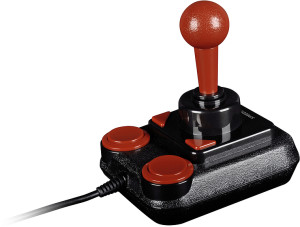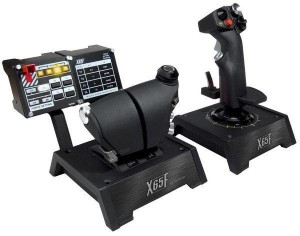How Does A Gaming Joystick Work
Joysticks essentially translate the movement of your hand into a digital format that a piece of software can then interpret to perform an action.
They’re used in a number of ways, from flying supersonic aircraft to controlling wheelchairs – to name just two – however joysticks are probably most commonly encountered as a major element of people’s gaming systems.
Simple joysticks, such as the one used to control games on the early Atari consoles, employ electric switches to detect the direction you are holding the stick in.
Inside the base is a printed circuit board with contact terminals arranged around the bottom of the stick. While the joystick is in a neutral state (ie at the centre), or the stick isn’t pressing the contacts into the ‘on’ position, the terminals cannot complete the electric circuit.
The gap in the circuit is closed when the terminals are pushed on, pressing a metal disc onto the board. The console then detects the charge on the wire and executes the appropriate action, whether that’s moving left, right, up, down, diagonally or something completely different, depending on how the software interprets it.
 The buttons on the joystick – often used for actions other than movement – work in much the same way.
The buttons on the joystick – often used for actions other than movement – work in much the same way.
Analogue joysticks are used for programs where a much greater range of movement is required – like flight simulators. Instead of pressing buttons to complete circuits, the bottom of the stick slots into two shafts – one that pivots on the X axis and another on the Y axis – with springs that return the stick to a central position when released. A pair of potentiometers (variable resistors) track the location of these shafts and thus determine the position you’re holding the joystick in.
Will any games work with this joystick today
The role of potentiometers
In an analogue joystick, as the base of the stick moves along the track of a shaft, a potentiometer (or pot) increases or decreases the resistance of the current in the X or Y-axis circuits accordingly. As opposed to the binary on and off state the contact terminals provide in a digital joystick, pots give an analogue range from the minimum value to the maximum value, depending on whether the stick is being pulled at its minimum range, its maximum range or somewhere in between. This signal still needs to be transformed into a digital numerical value though. A basic analogue-to-digital converter uses the voltage from the potentiometers to charge a capacitor, where a circuit with maximum resistance will charge more slowly than one with less resistance. By measuring the length of time the capacitor takes to charge fully, a numerical value can be ascertained.
Advanced joysticks
 In old analogue joysticks the analogue-to-digital conversion is handed over to the console or computer, requiring the system to continuously request data from the joystick, known as ‘polling’, to detect its current position. This can be a drain on system resources, so newer joysticks include an analogue-to-digital converter chip that translates the signal for the computer.
In old analogue joysticks the analogue-to-digital conversion is handed over to the console or computer, requiring the system to continuously request data from the joystick, known as ‘polling’, to detect its current position. This can be a drain on system resources, so newer joysticks include an analogue-to-digital converter chip that translates the signal for the computer.
Some of the latest joysticks avoid this problem altogether by using optical technology. The shafts are connected to slotted wheels, each placed between an LED with a photocell on the other side. When the wheel turns and a slot lines up with the cell, the light from the LED causes it to generate a current, switching off once it’s blocked again. Cutting-edge joysticks like the Saitek X-65F don’t even have moving parts -instead they respond to pressure exerted on the stick, which is exactly the same system found in modern fighter jet planes.
